Taking a victory lap back to where it all began

You don’t need to be a superhero to have an “origin story.” Many of us have them—only ours are about cars. The stories often begin something like this: “This cool kid on my street had a (fill in the blank).” My attraction to vintage BMWs stems directly from when a Hampshire College student, who owned a 1971 BMW 2002, lived with us for one summer, and he drove me around the back roads of Amherst, Massachusetts, forever impressing on me what this boxy little German sedan could do.
But my other origin story is the one that produced the ’74 Lotus Europa Twin Cam Special that I just spent seven years reviving. When I was 13, I worked at a stereo store in the alley behind Amherst center. The owner was a serial user of sports cars. One day he came to work driving a red Lotus Europa. I’d never seen a car so low and angular in the flesh before, and it seared itself into my adolescent synapses. Forty years later, when I had a bit of money burning a hole in my pocket, I bought mine, despite the fact that it hadn’t been on the road since 1979 and its engine had seized from sitting.
Last week, I wrote about the choices involved in upgrading a distributor before I purchased one and installed it in the Lotus. This week, spurred on by a bit of pandemic-induced restlessness, New England’s never-overrated fall foliage, and the desire to fully test the distributor and tweak the timing advance, I spent some quality time with the Lotus. At 220 miles, it wasn’t exactly a road trip, but it was the car’s longest drive to date.
The trip was also something of a victory lap. I had this idea that I’d head back to the scene of the crime and photograph the car in the location outside the stereo store where I’d first seen that red Europa 48 years ago. The problem was, the store was no longer there, and I knew that the old building in the alley that housed the stereo store and a bicycle shop where I’d also worked had long ago been replaced by a senior center and an underground parking garage. I looked at the area in Google maps, both in street view and satellite image formats, and my mind’s eye couldn’t quite superimpose on them where that red Europa had been parked, but I knew that if I simply drove there and looked at the area, I could figure it out.
So I began planning the Europa’s not-quite-a-road-trip, about twice the distance of its excursion to the Lotus Owners Groups (LOG) event in Sturbridge last summer when the just-resurrected car was still metaphorically wet behind the ears and literally wet around the base of the radiator cap. Amherst is about 100 miles west of where I live in suburban Boston. The 20-mile-long Quabbin Reservoir sits just east of Amherst, so to get there, you need to drive either north or south of it. The quicker way is to drive south, taking I-90 (the “Mass Pike”) and then cut north, but the more fun way is taking the twistier Route 2 to Route 202. As I described in a story last year, I have many memories associated with this winding stretch of road. What’s more, there’s a right turn off 202 that takes you through a section of stacked-up switchbacks, what locals call “The Shutesbury Chute,” sort of Quabbin’s tiny version of The Tail of the Dragon. The thought of doing The Chute in the Lotus literally lit up the pleasure centers in my brain.
I was immediately faced with the question of how much to pack. For the annual 2000-mile trips I take to the BMW event “The Vintage” in Asheville, North Carolina, I pack enough tools and parts to do full wheels-up repairs. I’ve written a lot over the years about “The Big Seven” things most likely to leave you stranded (ignition issues, cooling system issues, fuel delivery, charging, belts, clutch hydraulics, and ball joints). How many tools and parts you carry depends on the length of the trip and how recently and thoroughly you addressed Big-Seven-related maintenance issues.
The Lotus has reached the point where it’s a pretty well-sorted, though by no means restored, car. As per last week’s piece, the entire ignition system—coil, PerTronix distributor, cap, rotor, and plug wires—are new. The alternator was replaced this past spring. Every piece of the cooling system is new. Fuel delivery-wise, every rubber gas line and hose clamp has been replaced, but it is still running on its original mechanical fuel pump, so I made a note to throw a spare electric fuel pump in the trunk. The water pump and alternator belt are both new. There are no clutch hydraulics, just a new clutch cable. And I rebuilt the entire front end over the winter. Plus, a fluid leak in the transaxle was stanched, the brakes have been gone over stem to stern, the exhaust is new, and every light works. I really seemed to be in pretty good shape to pound out a few hundred miles.
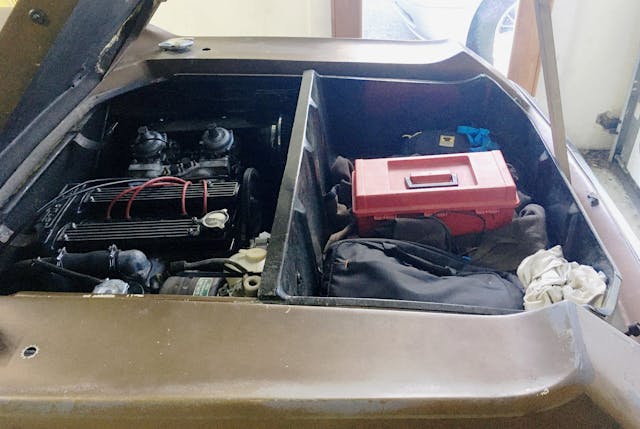
Note that “The Big Seven” assumes that stranding candidate number zero is a flat tire, the failure mode so high that nearly every car comes with a “spare”—and we don’t even ask “a spare what?” The Europa is a tiny car, but since the engine is in the middle, there are trunks at both ends, resulting in a surprisingly large amount of storage space. Some folks refer to the one in the nose as the “cold trunk,” and the rear-mounted bin next to the engine as the “hot trunk” (and I have hauled pizzas back there). The spare fits in the front trunk, though not easily. I’d pulled it out last year to make access to the brake master cylinder easier. I inflated the spare to recommended pressure, then carefully guided it back into yes-it-really-does-go-in-there position. I briefly entertained the notion of bringing the most compact floor jack I own, but decided to forgo the 20 pounds, since, if the car got a flat, a call to Hagerty Roadside Assistance would certainly produce a jack.
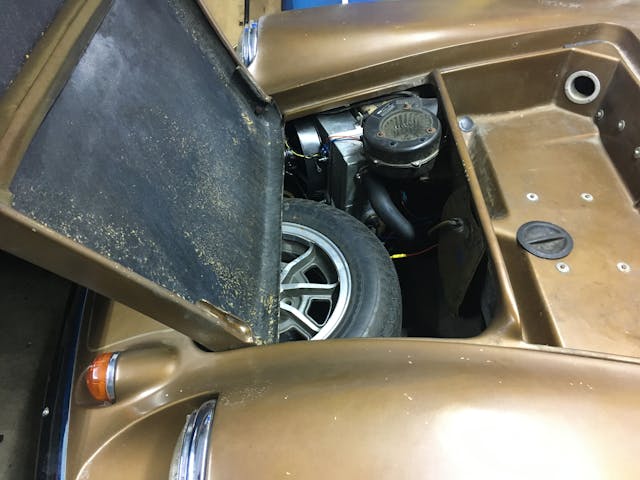
The more I thought about it, the more I felt that the trip was within the radius where, if the car died and needed to be flat-bedded home, the cost and hassle would be acceptable, so I could pack light. I put the Lotus up on the mid-rise lift, checked the wheel bearings, tightened one, crawled under the car, gave a tug on all the front-end bolts I’d installed last winter, checked for fluid leaks, found only a drop of antifreeze under the water pump seal and the requisite amount of British oil weeping, threw in my regular small travel tool box, a set of English spanners, a multimeter, and a Tyvec suit and pair of rubber gloves and called it good enough. I didn’t even take the original points-and-condenser distributor, since, as I said last week, the dizzy in the car is in a difficult-to-access location beneath the intake manifold. At about 11 a.m. the next day, I set off for Amherst on Route 2. About 30 minutes later, I realized I’d forgotten the spare electric fuel pump. D’oh!

The clear skies, t-shirt temperature, and not-yet-peak foliage were absolute heaven. Unfortunately, when I reached the section where Route 2 is no longer a divided highway, my pace was immediately slowed behind a long line of cars, and at age 62, I don’t have the stones for aggressive passing that I had when I was 18, and that’s a good thing. The slowpokes continued once I turned onto 202. Worse, I was crestfallen when I saw two of them signal right to take The Shutesbury Chute. Rather than have my blood pressure spike being forced to drive the Lotus at 30 mph through the switchbacks, I continued on 202, and briefly had some open asphalt until I caught up to the next bunch of cars.

So, it wasn’t the drive I’d hoped, but on the plus side, the car ran great, and I heard no knocking or pinging from the new distributor while under load.
As I reached Amherst center, an odd feeling came over me. There’s a funny juxtaposition of different points in your life that occurs when you drive a car you craved in your youth to a place you lived when you were young. And it’s not that Thomas Wolfe “You can’t go home again” thing, or “Hey, everyone, look at me, bet you never thought I’d be driving a Lotus,” at least it’s not with me. It took me a while to put my finger on what it was.
Cars are unique entities. They’re both a thing and a place. They’re physical objects with interior space that you inhabit while you move them around between different physical locations. I’m not sure there’s anything similar. No matter how small your living room is, you don’t drive your living room to where you used to live (campers and RVs notwithstanding). And yet we do this all the time with cars. Most of us like the feeling of familiarity that comes with getting back into our car as we use it as a conveyance. We just usually don’t think about it with daily drivers. With enthusiast cars, it’s more visceral because the whole experience with the car is more visceral. I realized that I’d experienced this odd feeling once before, the only time I drove my Triumph GT6+ back to the neighborhood where I grew up in Old Bethpage, Long Island. It’s like you’re taking two things you feel strongly about that normally have nothing to do with one another because you experienced them at different times and places, and you’re forcing them to exist in the same time and place. Only this time, they did have something to do with one another because I was intentionally returning, as it were, to the scene of the crime in the same model car.
OK, then, let’s find that 48-year-old parking spot.
I drove into town, scanned the north side of Main Street, and realized why I wasn’t able to reconcile my memory with Google maps. Back in the day, there had been two entrances to the alley, one of which was between two old buildings connected by an archway. The stereo store had been behind that entrance. The archway was still there, but the road through it was now a bricked-over foot-traffic-only entrance that wasn’t obvious on the map. I had to go in through the other entrance and cut over.
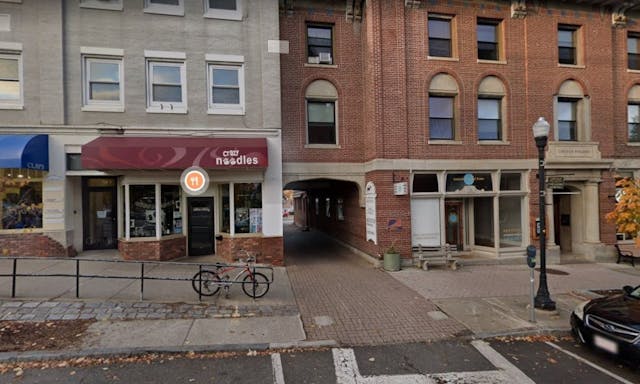
Whether it’s seeing an old friend decades later, or a place you once knew that’s changed, the brain goes through a funny pattern-matching process. It looks at the image that’s coming in through the eyes and compares it with what you have stored in memory. It may go ding ding ding, perfect match, or no match found, or report something fuzzy in between. Here, since what I was looking for was nothing more than a parking space in front of a long-gone building, I couldn’t simply look at a patch of parking lot and say, “Yeah, this was it.” But I put the Lotus as close as I could to the area that seemed to make sense and took the picture.
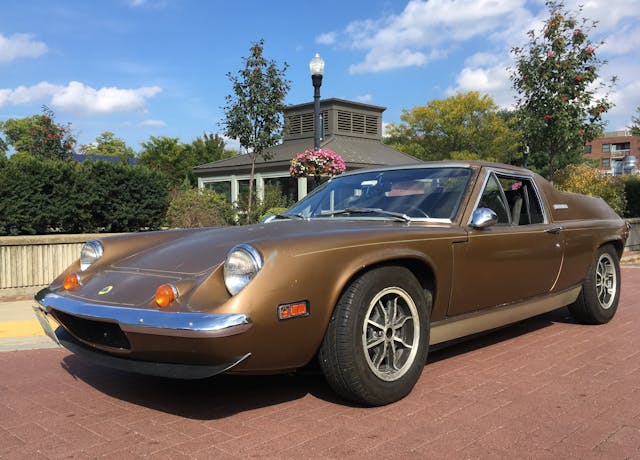
Before I left Amherst, the Lotus and I went on a mini tour of the places I lived. We went to 315 Middle Street, where the Hampshire student with the BMW 2002 lived with us for a summer; to 1 Maplewood Drive, where my Triumph GT6+ sat under the carport for more than half the time I owned it; to 32 Swiss Village Apartments, where I’d begged my eccentric roommate to let me borrow his Pontiac Tempest; to 125 Summer Street, where I maintained an International mini-school bus with a two-speed rear axle that belonged to a guy I was in a band with. I then made a surprise visit to a very old friend, who, as it turns out, had also worked one summer for the guy who owned the stereo store, driving a sketchy truck filled with sketchier stereo equipment from Nashua to Miami. It is sometimes a very small world of very old memories.
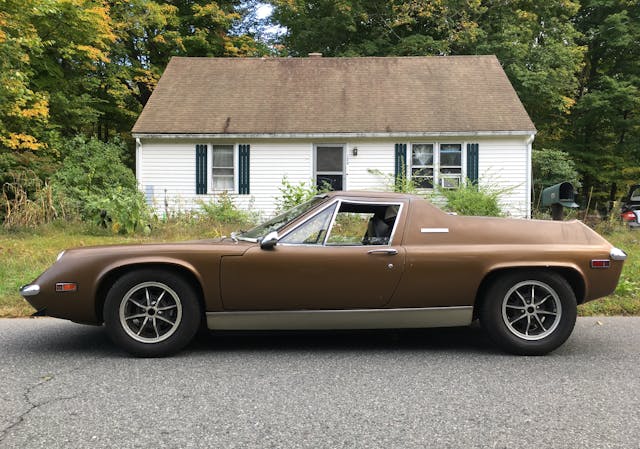
Even though all the lighting in the Lotus works, it is not a relaxing vehicle to drive after dark, as with its 42-inch roof height, I’m not certain that SUVs and trucks see it, and as a moose stepping in front of the fragile little fiberglass-bodied car at twilight would probably end both it and me, so at about 4 p.m. I beat retreat. I’d hoped that I’d have clearer roads for the drive home, but I got exactly four turns into The Shutesbury Shute before I found myself, again, stymied by safely driving Subarus. I did get off one crisp incredibly satisfying pass on Route 202 before traffic bunched up again.
But absolutely nothing went wrong with the Lotus in the 220 miles I drove it. The other shoe never dropped; I never needed the electric fuel pump that I’d forgotten—and “the other shoe” takes on added significance when driving a Europa, as unless you’re wearing ballet slippers, you need to remove your right shoe to drive it, because if you don’t, you mash the brake when you’re going for the gas, or vice versa.
The only matter that rose to the surface was a wheel balance issue. Before I began driving the resurrected car last year, I obviously replaced its 40-year-old tires. At the time, with the car still actively sucking cash out of my wallet, I went cheap, buying Achilles tires (I have a set on my BMW E39 sedan, and have actually been very happy with them). Unfortunately, when I first took the car on the highway, it had a bad steering wheel shimmy. I had the wheels and tires and Road force balanced, and that helped, as did rebuilding the car’s front end, but the problem still remains, and being in the car for several hours at highway speeds made me much more aware of it than I usually am in my 30-minute leafy-road pleasure drives. A friend who did the road force balancing said that the wheels are pretty straight and recommended that I spend some real money on name-brand tires.
After I got back, I realized something. While the Lotus was positioned in the alley, it attracted quite a bit of attention from young masked college students. So, who knows—maybe I’m an unwitting contributor to someone else’s origin story. Maybe I’ve set up my own ripple in time, where, 40 years from now, someone else will return with another Lotus and try to find that very spot.
Good thing I have the photo.
***
Rob Siegel has been writing a column (The Hack Mechanic™) for BMW CCA Roundel magazine for 34 years and is the author of seven automotive books. His new book, The Lotus Chronicles: One man’s sordid tale of passion and madness resurrecting a 40-year-dead Lotus Europa Twin Cam Special, is now available on Amazon (as are his other books), or you can order personally-inscribed copies from Rob’s website, robsiegel.com.


Funny enough, the tire jiggles of my MGB were reduced significantly after removing the wheel weights from the Road Force balance done last year. The plan was to try the CounterAct balance beads. It’s smooth enough at the moment to not go further with that plan yet.
By the way, there is an episode of Backroads USA of the 2 and 2A routes mentioned in this article. seems like top notch driving experiences.